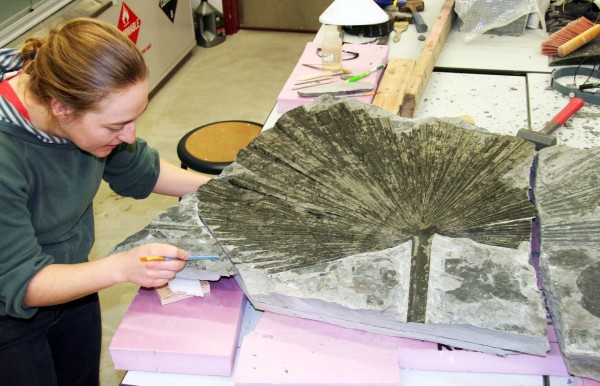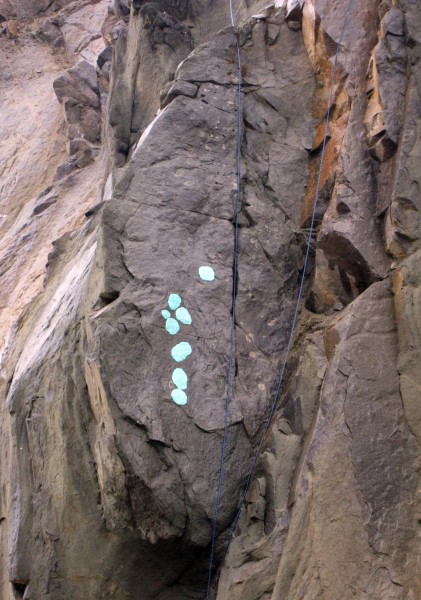Finding fossils in Alaska
June 8, 2015
Theresa Bakker
907-474-6941
During the Age of Dinosaurs, between 252 million and 66 million years ago, much of
Alaska was located farther north than it is today and featured lush forests full of
ferns. More than 20 different types of dinosaurs walked the land. Coastal waters teemed
with marine reptiles. The climate was much warmer.
How do we know? It’s all in the fossil record. Animal fossils can tell you who used
to live here and what they were eating. Plant fossils can tell you about the vegetation
that grew here and whether the climate was warmer or cooler than today.

Earth sciences curator Pat Druckenmiller said scientists study leaf and wood fossils for clues about climate. “Plant fossils, especially leaves, are like ancient thermometers. They can even tell us how much rainfall there was millions of years ago.”
In a new exhibit at the University of Alaska Museum of the North called “Expedition Alaska: Dinosaurs,” visitors can see a variety of Alaska fossils, including a six-foot wide palm leaf discovered last year in Southeast during the filming of a documentary about the geologic history of North America. The very presence of palm trees in this region indicates a much warmer period in Earth’s history.
There are different types of fossils. Body fossils are the bones, shells and teeth that have survived a long burial in the earth. Trace fossils are the marks the animals left behind, like dinosaur tracks or even their dung, called “coprolites” in paleontology terms.
The clues offered by these different types of fossils are similar to what we use for modern animals today. Sometimes we see the whole animal, a moose or bear in the woods, or a dead shrew on the forest floor. More often we find signs of the animal, things like tracks, gnawed trees or bits of fur on branches. This kind of knowledge and the ability to use it to reconstruct what happened is similar to the way paleontologists learn the story of the ancient past from fossils.
When Druckenmiller arrived at the museum, he found a photograph on his desk that featured an interesting set of dinosaur footprints running up the side of a rock face in Southwest Alaska. He also found a note saying they might be rocks from the Jurassic Period. “That made me excited because these would be the only Jurassic dinosaurs found in the state.”

In the summer of 2010, Druckenmiller and other scientists set up camp in a remote mountain range on the Alaska Peninsula where they found the dinosaur tracks from the photo. The researchers learned that they were made by meat-eating dinosaurs, a rare find in Alaska. They also confirmed that the rocks were Jurassic in age, which pushed the fossil record of dinosaurs in Alaska back about 50 million years.
Instead of slicing off the side of the cliff and bringing the footprints home with them, the crew spent the next several days making peels. The original footprints are impressions in the sandstone, so they used a silicone molding compound, pressing the material into the track and letting it set into a flexible peel they could easily carry to the museum.
Back in the lab, scientists poured plaster onto the mold, forming an exact replica of the original track, suitable for measuring, photographing and display.
Many of Alaska’s dinosaurs lived above the Arctic Circle, the northernmost dinosaurs that may have ever existed on the planet. The Mesozoic was a critical era in the state’s geological history. As Alaska was taking shape, powerful tectonic forces slammed new pieces of land against others, creating mountains.
Then erosion carried sediment into rivers and shallow seas, entombing the remains of some of the dinosaurs and marine reptiles of ancient Alaska.

The museum has a very exciting body fossil of one of them on display in the special exhibit. This remarkable, nearly complete skeleton was found on a small island in Southeast Alaska and is one of the most complete thalattosaur fossils known in the world.
Thalattosaurs are rare, prehistoric marine reptiles. They range in length from three to ten feet and have long, flattened tails and paddle-like limbs. Some have downturned snouts, like modern lizards. They evolved from land-dwellers and lived only during the Triassic Period.
Museum scientists traveled to the site in 2011 to collect the specimen from an outcrop of rock exposed at low tide. The team used rock saws to hack a 500-pound slab surrounding the fossil out of the intertidal zone. They shipped it back to the museum, where several years of careful work cleaning away the extra rock eventually revealed the animal’s skull and hind limbs.
Druckenmiller said it is one of the best-preserved and most complete fossil vertebrates ever found in Alaska. “What is really cool about this thalattosaur is that it’s very different from any other known species. In other words, it’s a brand new species and we have the fun job of coming up with a new scientific name for it.”
TRY THIS AT HOME: Create your own fossil! Make or use play dough you buy at the store. Find leaves, cones, needles and other objects to press into the dough to make an impression. Remove the object and let the dough dry. Experiment with different shapes. Try using dino toys to create trackways across your dough.
IF YOU GO: Explore authentic Alaska fossils at “Expedition Alaska: Dinosaurs” on display in the museum’s Special Exhibits Gallery.


